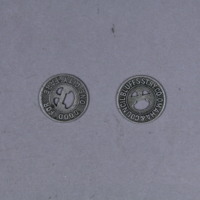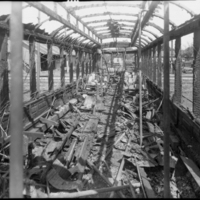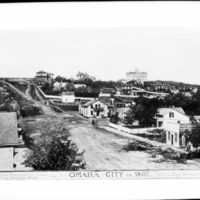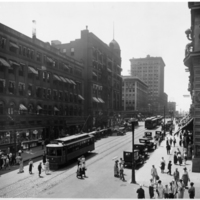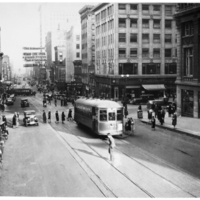Streetcar Tokens
Title
Subject
Streetcar tokens were once a large part of American life. In the late 1800s, city sizes, structures, and functions changed. Why? Because streetcars allowed people to live in suburbs, away from their job in the city. Before the streetcar, the largest US cities did not extend more than two miles from their center. Today, most Americans travel over 10 miles to work. In Omaha, streetcars played an important role in this transition. Between 1886-1955, the Omaha and Council Bluffs Railway and Bridge Company (O&CB) operated an extensive streetcar system. By 1955, the car had already begun to replace mass transportation. With cars, the environmental consequences of suburban growth accelerated. As people lived further away from their work, vehicular emissions skyrocketed. Today, transportation accounts for over a quarter of US greenhouse gas emissions. The legacy of streetcar tokens lives on in the dollar bills spent on gasoline.
Description
Streetcar tokens, the object of display in The Durham Museum, provide a stand-in for measuring streetcar popularity over time. (Figure 2) While the overall circular shape of the tokens remained largely stable, their value consistently decreased throughout the streetcar era. In order to ride the streetcar in 1919, fares were four for a quarter. By 1930, a fare was three tokens for a quarter and by 1950 it became two tokens for a quarter. (Orr, 1996)
The development of streetcars depended on an earlier movement away from pedestrian traffic to other forms of mass transit. Omnibuses (enclosed, horse-drawn passenger vehicles) and horse-drawn carriages debuted prior to streetcars, and had large influences as the first means of public transportation in urban areas. As the nineteenth century advanced, electric railway and streetcar systems overtook those less-sophisticated technologies. By the 1890s, nearly every major US city contained an electric railway or streetcar system. (Chudacoff, 1975) In fact, in 1890, there were about 800 streetcar companies responsible for carrying approximately two billion passengers throughout the US. By 1903, the US had about thirty thousand miles of streetcar tracks, nearly all of them were electrified. (Wells, 2014) Electric streetcars changed the composition of city streets and the composition of cities themselves. (Figure 3) Due to the increased speed of travel, commuters were able to live farther and farther away from their workplace, and “streetcar suburbs” were born. Chicago, a city where cable cars and electric streetcars were hugely popular in the early 1900s, is a great example for the impact of streetcars on suburban growth. Between 1890 and 1920, 250,000 residential lots were recorded on the borders of its city limits, and another 550,000 in regions just outside those limits. (Chudacoff, 1975) The invention of the electric streetcar proved to be the first major transportation innovation leading to the current suburbia-dominated landscape surrounding urban areas.
Streetcars were equally important in Omaha. The Omaha and Council Bluffs Railway and Bridge Company (O&CB) dominated the streetcar industry in the region. Omaha was first occupied by omnibus transport, then horse-pulled streetcars. In 1886, the O&CB became incorporated, and secured a monopoly over the region. (Orr, 1996) The O&CB streetcar company was one of the first in the nation to introduce an electric streetcar system. Shortly after incorporation, electric streetcar railways extended throughout the city center and into surrounding neighborhoods. (Figure 4) The last streetcar ride through Omaha took place in 1955, completing the city-wide transformation into buses as the newest public transportation media. (Orr, 1996) The nearly 70-year history of electric streetcar systems in Omaha may be best characterized by controversial and often violent clashes between company and community.
Many strikes against streetcar companies were headed by a local civil rights group, known as the De Porres Club, which was led by Mildred Brown and Rev. Markoe S.J. Brown was the co- founder and publisher of the Omaha Star, which is a newspaper predominantly for the African American citizens of Omaha. During her time as a publisher for the Omaha Star, she used her journalistic rights to spread the word of civil rights activism by putting initiatives in her paper that were put on by the De Porres Club. She provided a voice for residents in the North side of Omaha, where the population was an is predominately African American. She explained to her readers that she wanted, “freedom from fear, want, and the right to equal opportunity.” Through her activism she caught the eye of Rev. John Markoe, a Jesuit at Creighton, and six white Creighton University students that founded the De Porres Club on November 3, 1947.
The De Porres Club led many strikes and rallies to stop discrimination of African Americans in the Omaha area. From 1909 to 1919, the black population grew 113%, most of whom lived in North Omaha. The De Porres Club held their meetings at the Omaha Star when they ran out of funding to support their own facility.(National Register of Historic Places, 2007) The De Porres Club first meeting in Omaha attracted a total of forty-seven people. Rev. Markoe S.J. was a former West Point graduate recently banished from St. Louis University’s Jesuit community due to civil rights advocacy. Markoe’s goal for the De Porres club was “better racial relations through constructive actions, to banish every form of compulsory segregation and abolish any and all forms of discrimination against individuals because of race, color or creed.” Ultimately, Creighton University, fearful of public backlash, severed any and all ties from the organization. Brown and the De Porres Club took the Omaha community by storm with their civil rights movements. They had many strikes in the Omaha area and a few were with the Omaha and Council Bluffs Street Railway Company. (National Register of Historic Places, 2007)
In 1952, Brown and the De Porres Club challenged the Omaha and Council Bluffs Street Railway Company’s policy of no black bus drivers. In response, the streetcar management opined in 1952 that, “No white woman would be safe on a street car if there was a black [man] driving.” The Star pushed back forcefully against this discriminatory characterization. It provided upset readers with home address and phone numbers of company officials. Brown used the Star to keep people from using public transportation in Omaha by stating in an article to either pay less (18 pennies) or stay away. This transportation boycott was one of the first of the nationwide civil- rights transportation boycotts, and predated the Montgomery, Alabama bus boycott of 1955-1956 by a few years. (Forss, 2011)
Nationwide trends were also wrought with negativity. As streetcar popularity increased, so too did city congestion, waiting periods, and public complaints. Indeed, the history of streetcars is one of controversy between business and consumer. In order to maximize patronage and minimize expense, streetcars tended to serve only the locations of the highest densities, resulting in heavily- crowded city centers with ever-frustrating traffic jams. Despite growing public distaste for the perpetual ways of business within the streetcar industry, companies often failed to provide solutions, such as larger, faster, and more comfortable cars, as well as more frequent services. (Wells, 2014) Consumers frequently accused streetcar companies of other activities, including “bribing City Council members, disregarding the public's safety, ignoring the community's needs, abusing their franchise privileges, and profiting at the public's expense.” (Bottles, 1987) In Omaha, major union clashes and strikes against the OC&B took place in 1909, 1918, 1934, and 1935. (Orr, 1997) (Figure 4) The violence and unrest in June of 1935 was so overwhelming the city was put into martial law.
All of the civil unrest, controversy, and public distaste of streetcar monopolies created a market for a new type of transportation, one for which consumers no longer needed to rely on time-schedules and station locations to commute. Indeed, automobiles liberated millions of Americans from reliance on streetcars; cities were also becoming increasingly decentralized, and many Americans were becoming less dependent on city centers for everyday items and services. These factors led to the stark decline of streetcar popularity beginning in the 1920s through the 50s. (Wells, 2014)
As streetcars declined, car markets boomed. With cars came ever-increasing city limits and an accelerated expansion of suburbia. It was during this era that the full environmental implications of urban and suburban expansion came to be realized. While the effects of replacing natural geographical landscapes with concrete and steel can have large effects on global and local environments, the effects of carbon emissions have global environmental implications.
The connection between rising CO2 emissions from the onset of the Industrial Revolution and rising global temperatures is well publicized. The exponential growth of CO2 from the nineteenth century into the twentieth century is frequently tied to global warming, as CO2 serves an ever-growing heat trap in our atmosphere, causing an overall warming of the climate. When examining the history of Western CO2 emissions, historians Christophe Bonneuil and Jean- Baptise Fressoz claim, “The suburbanization and motorization of Western societies are certainly the most massive example of a technological and civilizational choice that is profoundly suboptimal and harmful." (Bonneuil and Fressoz, 2015) The pattern of increased suburban sprawl with increased automobile usage correlates strongly with dramatic increases in CO2 emissions in the US during the mid- 1900s into the 1970s. Not only were people driving more, but city surface areas were also increasing. Alain Bertaud and Harry W. Richardson, well noted urban scholars, convincingly point to the relationships between city surface areas and CO2 emissions when comparing Atlanta with Barcelona. (Bertaud and Richardson, 2004)
Barcelona, despite having a higher population, has over ten times less transport carbon emissions than Atlanta, a city with a much higher urban area. High density urban environments tend to be more “green” in terms of carbon dioxide emissions. Cities in the United States, such as Atlanta, have spread significantly further in surface area (on average), largely due to the early influence of streetcars and modern influence of cars. As population densities spread and people live further away from their work, vehicular emissions skyrocketed. When these trends are applied to an ever-industrializing and urbanizing planet, the consequences become convincing evidence for the Anthropocene origins in the Great Acceleration beginning in the 1950’s as production of automobiles escalated along with the burning of fossil fuels.
The problems of urban sprawl do not end at city limits, either. Researchers at California Berkeley conducted a study examining the per-household carbon emissions by county across the entire United States. As evidenced by an interactive US map, urban areas of high population density tend to have relatively low per-household carbon emission levels. However, levels quickly grow as distance from the city center increases, with the highest levels of carbon emissions located often in residential suburbs surrounding big cities. While these patterns are prevalent throughout the United States, including Douglas County, Nebraska, which contains Omaha, Eastern metropolises demonstrate the pattern very clearly. (Jones and Kammen, 2014)
In other words, suburban development has massive implications in CO2 generation. Transportation accounts for over a quarter of all US greenhouse gas emissions per year, mostly produced by the burning of petroleum (gasoline and diesel). (EPA, 2017) As cities and suburbs continue to grow in population, CO2 emissions become increasingly relevant in addressing climate change. Urban areas tend to be “greener” due to higher levels of mass transportation and shorter commutes to work. People living in cities tend to live closer to their workspace, reducing the need for longer transportation routes and increasing the utility of public transport systems.
The history of the streetcar, in Omaha and beyond, is one of civil and environmental struggle. Poor service and racist practices inspired activism from organizations like the De Porres club to demand change. Change came in large part with the automobile, which displaced the streetcar and became the most dominant form of transportation in the US. Today, Omaha is considering the implementation of an expensive streetcar system that would travel through the downtown area. Public officials claim the system will increase the value of developments along its route, and cause economic stimulation. The project is, in large part, designed to incentivize more people to reside in the Omaha City Center. Across the nation, streetcars have been framed by city officials as potential economic boosts, acting as tourist attractions as well as improving property values. Streetcars initially played an active role in expanding city centers outward, and are now being designed to pull people in. In light of Omaha history, city officials should carefully consider the location of streetcar lines to benefit all communities. Also, as cities continue to grow in population density, creating “green” alternatives to unhealthy CO2 emission become more relevant. Perhaps incentivizing people to live downtown can play a significant role in reducing transportation CO2 emissions. However, much more innovation is necessary to reverse the increasing rate of planetary environmental change.
Creator
Mary McClure
Source
Bonneuil, Christophe and Fressoz, Jean-Baptiste. “Thanatocene: Power and Ecocide," The Shock of the Anthropocene: The Earth, History and Us. Verso, 2015.
Bottles, Scott. Los Angeles and the Automobile: The Making of the Modern City. Berkeley: University of California Press, 1987.
Chudacoff, Howard. The Evolution of American Urban Society. Englewood Cliffs, N.J: Prentice- Hall, 1975.
Forss, Amy H. “Mildred Brown and the De Porres Club: Collective Activism in Omaha, Nebraska’s, Near North Side, 1947-1960.” Nebraska State Historical Society, February 18, 2011. http://nebraskahistory.org/publish/publicat/history/full- text/NH2010DePorres.pdf
Jones, Chrisopher and Kammen, Daniel. “Average Annual Household Carbon Footprint by Zip Code” CoolClimate Network, University of California Berkeley. http://coolclimate.berkeley.edu/maps Jones, Christopher and
Kammen, Daniel. “Spatial Distribution of U.S. Household Carbon Footprints Reveals Suburbanization Undermines Greenhouse Gas Benefits of Urban Population Density,” Environmental Science and Technology 48, no. 2 (2014).
Orr, Richard. O & CB: Streetcars of Omaha and Council Bluffs. Omaha, NE: R. Orr, 1996.
“Sources of Greenhouse Gas Emissions,” Environmental Protection Agency, 2017. https://www.epa.gov/ghgemissions/sources-greenhouse-gas-emissions United States Congress.
“National Register of Historic Places Registration Form.” United States Department of the Interior National Park Service, 2007. www.nps.gov/nr/publications/sample_nominations/Omaha%20Star.pdf.
United States Department of Transportation. “National Household Travel Survey.” Bureau of Transportation Statistics. 1995. https://www.rita.dot.gov/bts/sites/rita.dot.gov.bts/files/subject_areas/national_household_ travel_survey/index.html.
Wells, Christopher. Car Country: An Environmental History. Vancouver: University of Washington Press, 2014.
Collection
Citation
Embed
Copy the code below into your web page
